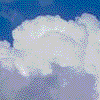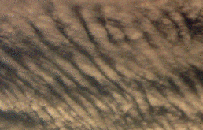 |
||
| First page | ||
 |
||
| High clouds | ||
 |
||
| Middle clouds | ||
 |
||
| Low clouds | ||
 |
How/Why study? | |
 |
||
| Find out more | ||
 |
||
 |
||
High altitude clouds
25-40,000 feet.
The type of clouds most often found in the high level etage are cirrus, cirrocumulus and cirrostratus. These clouds are made up mostly of ice crystals and they are usually bright or mostly white, except near sunrise or sunset when the cloud reflects sunlight that has not been scattered by the atmosphere and produces some very beautiful and colourful cloud patterns.
Cirrus
 The Cirrus clouds consist almost exclusively of ice crystals that appear on the sky in white delicate patches or narrow bands. Most cirrus clouds are semi-transparent because the ice particles are very small and low in number. The common English name for a cirrus cloud is Mare's Tails since the long threads of cloud often resemble a horse's tail. Cirrus clouds are sometimes a sign that wet and stormy weather might be coming.
The Cirrus clouds consist almost exclusively of ice crystals that appear on the sky in white delicate patches or narrow bands. Most cirrus clouds are semi-transparent because the ice particles are very small and low in number. The common English name for a cirrus cloud is Mare's Tails since the long threads of cloud often resemble a horse's tail. Cirrus clouds are sometimes a sign that wet and stormy weather might be coming.
Cirrus clouds are distinguished from cirrocumulus by their mainly fibrous or silky appearance. They also don't have any small cloud elements in the form of grains, ripples, etc. Cirrus clouds are distinguished from Cirrostratus by their discontinuous structure.
Cirrocumulus
 This cloud is also composed of tiny globules of ice crystals. It usually has a regular pattern of lines, resembling the ripples left in the sand on the seashore after the tide. These patterns are caused by the variations in wind speed above the cloud, imparting a rolling motion to the air. The same type of ripples can often be seen in other clouds at lower levels. Cirrocumulus is different from Cirrus and Cirrostratus in that it consists of many very small fractions of clouds. Cirrocumulus differs from Altocumulus in that most of its elements are very small and without shading.
This cloud is also composed of tiny globules of ice crystals. It usually has a regular pattern of lines, resembling the ripples left in the sand on the seashore after the tide. These patterns are caused by the variations in wind speed above the cloud, imparting a rolling motion to the air. The same type of ripples can often be seen in other clouds at lower levels. Cirrocumulus is different from Cirrus and Cirrostratus in that it consists of many very small fractions of clouds. Cirrocumulus differs from Altocumulus in that most of its elements are very small and without shading.
Cirrostratus
 As the name implies, this cloud often develops from Cirrus and it is composed of a layer of ice crystals. Cirrostratus presents a semi-transparent, hair-like cloud of smooth appearance. It is usually covering the sky (totally or partly) and this is because of the smallness of the ice crystals, their sparseness and the fact that cirrostratus isn't very "deep". Cirrostratus differs from altostratus by its thinness and by the fact that it may show a halo phenomena. Cirrostratus is never thick enough to prevent objects on the ground from casting shadows, at least when the sun is high above the horizon.
As the name implies, this cloud often develops from Cirrus and it is composed of a layer of ice crystals. Cirrostratus presents a semi-transparent, hair-like cloud of smooth appearance. It is usually covering the sky (totally or partly) and this is because of the smallness of the ice crystals, their sparseness and the fact that cirrostratus isn't very "deep". Cirrostratus differs from altostratus by its thinness and by the fact that it may show a halo phenomena. Cirrostratus is never thick enough to prevent objects on the ground from casting shadows, at least when the sun is high above the horizon.
15th October 2000
Sarah Amandusson
www_astro@mssl.ucl.ac.uk